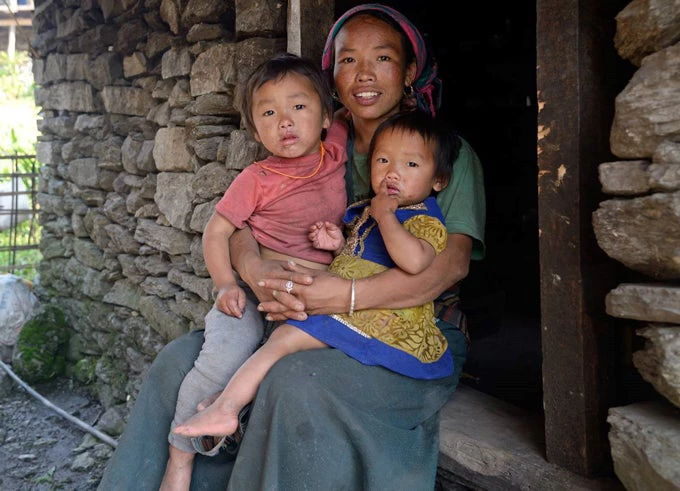
Lahjung Bhotia is from Hatiya, Sankhuwasabha, a remote mountainous district in Eastern Nepal. She and her husband rent land and grow black cardamom with a third of the production going to the land owner. On the side, the couple runs a small tea shop, selling cold drinks, eggs and biscuits. She and her husband take turns working at the shop and the farm and she claims to be doing okay, not terribly good, but just okay. Her life’s singular objective is to educate her children well enough so that they can work in offices.
Lahjung is one of a third of Nepalis who have benefitted from the remarkable progress on poverty reduction the country has experienced in the last two decades despite overwhelming challenges of conflict and political instability. Yet, she is also one of almost a half of the country’s population who may not be poor based on the national definition of poverty but has to work constantly to make ends meet. She may have some savings, but barely enough to cope if a small shock such as poor rainfall wipes out their cardamom yields, or an illness or an accident consigns her husband to bed for a month or two.
Her desire to give her children a good education is strong, but will she be able to find good education in the public schools of Hatiya? If not, will she have enough saved to send her children to any of the mushrooming private schools in the district headquarters, Khandbari? Or even further south in Dhankuta or Dharan? Will they have to move to the city to look for better jobs to afford such schools? Or would using all of their savings to bear the cost of a three-year stint for her husband in Qatar be a better bet?
Millions of Nepalis grapple with similar questions today. In a new report “Moving Up the Ladder: Poverty Reduction and Social Mobility in Nepal”, we take stock of the trends and drivers of living standards changes in Nepal in the last two decades and identify key challenges that lie ahead in improving the economic conditions of Nepalis, particularly the poor and the vulnerable.
The report also looks at levels and trends in inequality in the last two decades to understand the economic underpinnings of the demand for inclusion that has so fundamentally shaped Nepal’s contemporary socio-political landscape. How high is inequality in Nepal? How does it compare to the rest of the world? Has inequality been increasing?
There is a general perception of deep “structural inequalities” and these inequalities are often closely linked to the level of mobility in any society. In an intergenerational sense, when children can aspire to achieve and indeed achieve levels of education, jobs, and living standards that are higher and better than the levels enjoyed by their parents, inequality begins to decline over time. Conversely, if the prospects of mobility are low, then these inequalities compound further.
The report complements the analysis of inequality with some insights on social and economic mobility experienced by Nepalis across generations as well as over a lifetime. Have Nepalis today done better than their parents? How does this mobility experience vary across the population? Who does better and who remains stuck? Are Nepalis today better off than they were five years ago? How much movement along the socio-economic ladder is there in the Nepali society? What characteristics are associated with these movements? That is, who moves up and who moves down?
Like Lahjung, the “socio-economic status” every Nepali adult finds herself in today is a reflection of the kind of opportunities she had in her childhood. But to some extent it is also a reflection of what she made of these opportunities. Some argue that all inequality is unfair. Others argue that individuals cannot and indeed should not be rewarded equally irrespective of their effort, choices in life or innate talent. If somebody works hard and makes better choices, it is only fair that she gets rewarded suitably.
But there is a greater agreement around the idea that a person’s predetermined circumstances such as gender, caste/ethnicity, place of birth, family origins should not determine the chances of their economic, social and political success. In other words, there may be ambivalence about Lahjung’s position in society today, but most will agree that her children should have as much of an equal shot at becoming a doctor or an engineer or anything they aspire to become as any other child growing up in a more privileged setting.
In fact, ensuring that this happens is not just equitable and fair, but also critical for an inclusive and a prosperous Nepal.
As we launch this report, we invite you to stay tuned and follow a series of blogs we will be posting to stimulate discussion and debate around particular components of the analysis. We also invite you to follow our unique collaboration with Stories of Nepal on Facebook. This will feature a special set of stories highlighting not just the humbling accounts of everyday trials and tribulations of real Nepalis but also their hopes, aspirations and triumphant efforts to alter their economic circumstances.



Join the Conversation